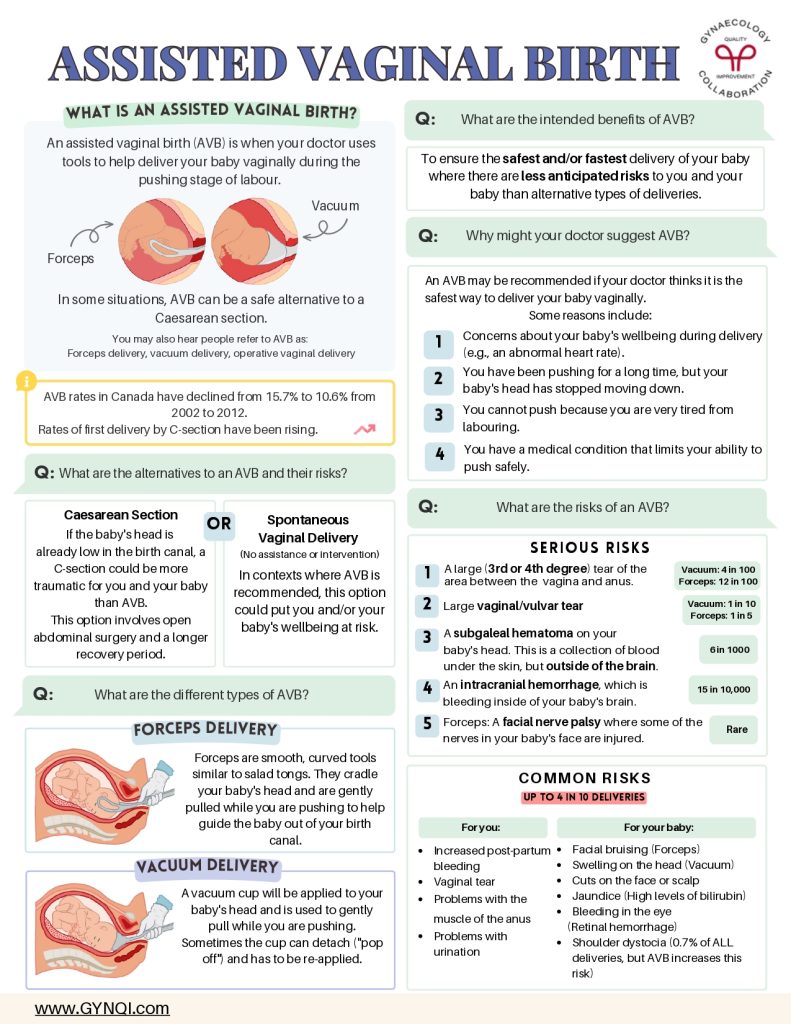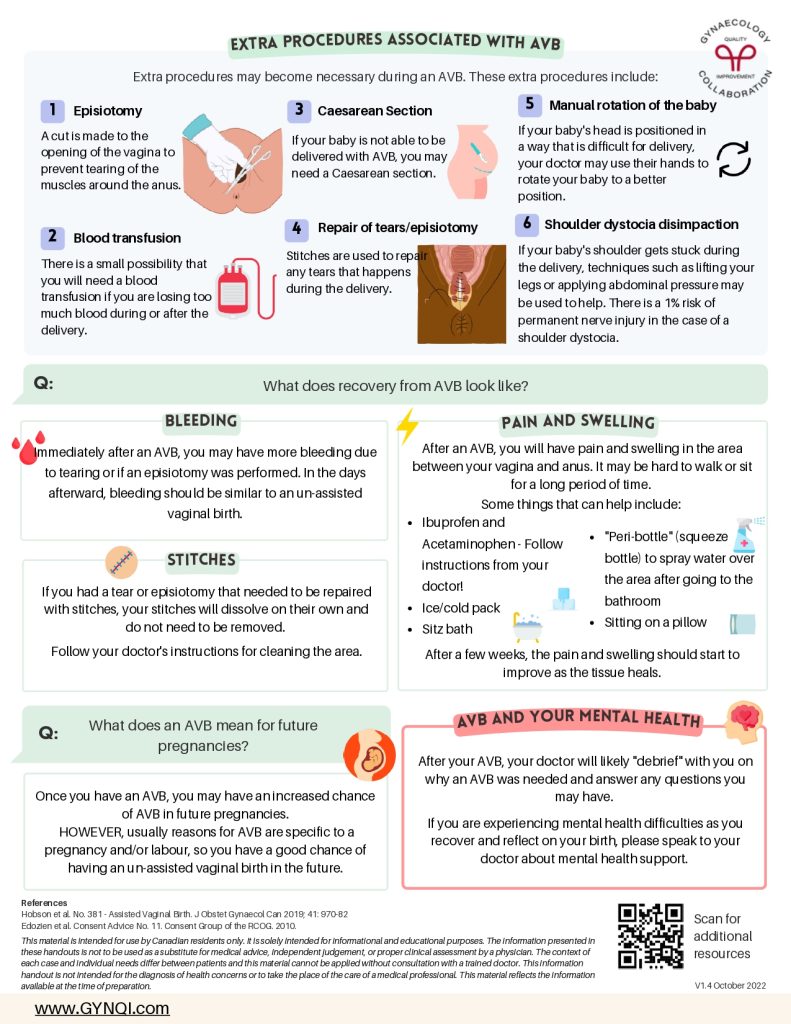
Assisted Vaginal Birth
What Is an Assisted Vaginal Birth?
An assisted vaginal birth (AVB) is when your doctor uses tools to help deliver your baby vaginally during the pushing stage of labour. In some situations, AVB can be a safe alternative to a Caesarean section. You may also hear people refer to AVB as: Forceps delivery, vacuum delivery, operative vaginal delivery.
AVB rates in Canada have declined from 15.7% to 10.6% from 2002 to 2012. Rates of first delivery by C-section have been rising.
What Are the Alternatives to an AVB and Their Risks?
Caesarean Section
If the baby’s head is already low in the birth canal, a C-section could be more traumatic for you and your baby than AVB. This option involves open abdominal surgery and a longer recovery period.
OR
Spontaneous Vaginal Delivery (No assistance or interventions)
In contexts where AVB is recommended, this option could put you and/or your baby’s wellbeing at risk.
What Are the Different Types of AVB?
Forceps Delivery
Forceps are smooth, curved tools similar to salad tongs. They cradle your baby’s head and are gently pulled while you are pushing to help guide the baby out of your birth canal.
Vacuum Delivery
A vacuum cup will be applied to your baby’s head and is used to gently pull while you are pushing. Sometimes the cup can detach (“pop off”) and has to be re-applied.
What Are the Intended Benefits of AVB?
To ensure the safest and/or fastest delivery of your baby where there are less anticipated risks to you and your baby than alternative types of deliveries.
Why Might Your Doctor Suggest AVB?
An AVB may be recommended if your doctor thinks it is the safest way to deliver your baby vaginally. Some reasons include:
- Concerns about your baby’s wellbeing during delivery (e.g., an abnormal heart rate).
- You have been pushing for a long time, but your baby’s head has stopped moving down.
- You cannot push because you are very tired from labouring.
- You have a medical condition that limits your ability to push safely.
What Are the Risks of an AVB?
Serious Risks
- A large (3rd or 4th degree) tear of the area between the vagina and anus.
- Vacuum 4 in 100
- Forceps 12 in 100
- Large vaginal/vulvar tear
- Vacuum: 1 in 10
- Forceps: 1 in 5
- A subgaleal hematoma on your baby’s head. This is a collection of blood under the skin, but outside of the brain.
- 6 in 1000
- An intracranial hemorrhage, which is bleeding inside of your baby’s brain.
- 16 in 10000
- Forceps: A facial nerve palsy where some of the nerves in your baby’s face are injured.
- Rare
Common Risks
For you:
- Increased post partum bleeding
- Vaginal tear
- Problems with the muscle of the anus
- Problems with urination
For your baby:
- Facial bruising (Forceps)
- Swelling on the head (Vacuum)
- Cuts on the face or scalp
- Jaundice (High levels of bilirubin)
- Bleeding in the eye (Retinal hemorrhage)
- Shoulder dystocia (0.7% of ALL deliveries, but AVB increases this risk)
Extra Procedures Associated With AVB
Extra procedures may become necessary during an AVB. These extra procedures include:
- Episiotomy: A cut is made to the opening of the vagina to prevent tearing of the muscles around the anus.
- Blood transfusion: There is a small possibility that you will need a blood transfusion if you are losing too much blood during or after the delivery.
- Caesarean Section: If your baby is not able to be delivered with AVB, you may need a Caesarean section.
- Repair of tears/episiotomy: Stitches are used to repair any tears that happens during the delivery.
- Manual rotation of the baby: If your baby’s head is positioned in a way that is difficult for delivery, your doctor may use their hands to rotate your baby to a better position.
- Shoulder dystocia disimpaction: If your baby’s shoulder gets stuck during the delivery, techniques such as lifting your legs or applying abdominal pressure may be used to help. There is a 1% risk of permanent nerve injury in the case of a shoulder dystocia.
What Does Recovery from AVB Look Like?
Bleeding
Immediately after an AVB, you may have more bleeding due to tearing or if an episiotomy was performed. In the days afterward, bleeding should be similar to an un-assisted vaginal birth.
Stitches
If you had a tear or episiotomy that needed to be repaired with stitches, your stitches will dissolve on their own and do not need to be removed. Follow your doctor’s instructions for cleaning the area.
Pain and Swelling
After an AVB, you will have pain and swelling in the area between your vagina and anus. It may be hard to walk or sit for a long period of time. Some things that can help include:
- Ibuprofen and acetaminophen – Follow instructions from your doctor!
- Ice/cold pack
- Sitz bath
- “Peri-bottle” (squeeze bottle) to spray water over the area after going to the bathroom
- Sitting on a pillow
After a few weeks, the pain and swelling should start to improve as the tissue heals.
What Does an AVB Mean for Future Pregnancies?
Once you have an AVB, you may have an increased chance of AVB in future pregnancies. HOWEVER, usually reasons for AVB are specific to a pregnancy and/or labour, so you have a good chance of having an un-assisted vaginal birth in the future.
AVB and Your Mental Health
After your AVB, your doctor will likely “debrief” with you on why an AVB was needed and answer any questions you may have. If you are experiencing mental health difficulties as you recover and reflect on your birth, please speak to your doctor about mental health support.





